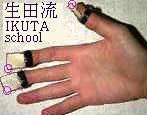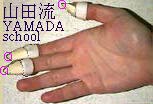Sit in front of the KOTO
The sitting position for playing the KOTO is directly in front of, and on the right of the instrument. The player leans forward and plucks the strings about 3-5cm from the right. The traditional way of playing the KOTO is by resting the right end on a small pillow, so that the instrument is balanced about 8cm above TATAMI-mat flooring. In this case, the kneels on the TATAMI. Nowadays some players prefer to rest the KOTO on a stand and sit in a chair to play it.
Put three picks on your two fingers and thumb of the right hand

 The strings are plucked by using ivory picks called TSUME, meaning nail in Japanese. Three TSUME are used, and are placed on the forefinger, middle finger, and thumb of the right hand. The shape of the TSUME differ depending on the particular school involved. There are 2 schools, YAMADA (see picture on the left) and IKUTA tradition(see picture on the right). The red marks in each picture indicate the points where the strings should be plucked. In the YAMADA style, the tips of the picks are used, the player's knees rest evenly against the KOTO. In the IKUTA style, the left edge of the thumb's pick and the right edges of the finger picks are used, so the optimum sound can be achieved by sitting at a 45 degree angle to the left. Although these picks have been made traditionaly out of ivory, it is increasingly difficult to obtain ivory, alternative materials are now being sought.
The strings are plucked by using ivory picks called TSUME, meaning nail in Japanese. Three TSUME are used, and are placed on the forefinger, middle finger, and thumb of the right hand. The shape of the TSUME differ depending on the particular school involved. There are 2 schools, YAMADA (see picture on the left) and IKUTA tradition(see picture on the right). The red marks in each picture indicate the points where the strings should be plucked. In the YAMADA style, the tips of the picks are used, the player's knees rest evenly against the KOTO. In the IKUTA style, the left edge of the thumb's pick and the right edges of the finger picks are used, so the optimum sound can be achieved by sitting at a 45 degree angle to the left. Although these picks have been made traditionaly out of ivory, it is increasingly difficult to obtain ivory, alternative materials are now being sought.
Make the base pitch
Before starting to play KOTO, the instrument must be tuned. To begin with, 13 bridges (called ZI) should be placed under each string. the bridges are then adjusted until the strings make the correct sound of the base pitch. The most popular base pitches in KOTO music are as follows, each string having its own name, and starting from the lower side, ICHI(1), NI(2), SAN(3), SHI(4), GO(5), ROKU(6), SHICHI(7), HACHI(8), KU(9), ZYU(10), TO(11), I(12), KIN(13). Five strings are equal to one octave. The #s are somewhat lower than in the western music system. Please listen to my KOTO and tune your own by ear!
 Hira-tyoshi("Rokudan""Midare" etc.) Hira-tyoshi("Rokudan""Midare" etc.) |
 Kokin-tyoshi("Chidorinokyoku" etc.) Kokin-tyoshi("Chidorinokyoku" etc.) |
 Hon-kumoi-tyoshi("Kumoinokyoku" etc.) Hon-kumoi-tyoshi("Kumoinokyoku" etc.) |
 Gaku-tyoshi("Chikubushima" etc.) Gaku-tyoshi("Chikubushima" etc.) |
The KOTO will also allow you to make your own pitch, for example, like the piano tuning or dodecaphony or whatever you want. That will be much more interesting for you!!


 Back to KOTO home page
Back to KOTO home page